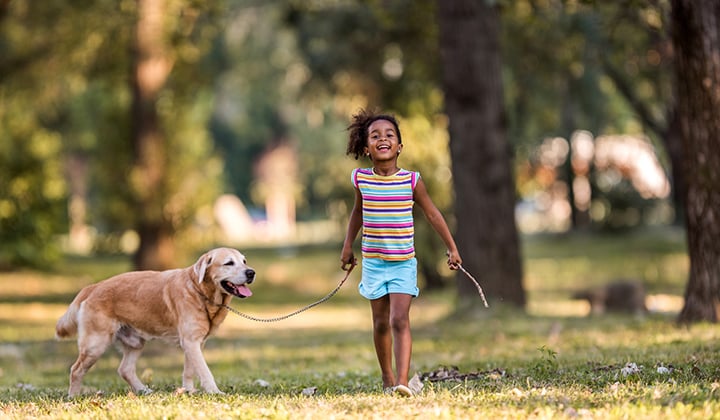
We know to teach kids to look before crossing the street and to not run with scissors. These are all well-known safety skills parents always talk about with kids. But we should be teaching a few safety things when it comes to dogs, too.
It’s one of the worse things to imagine, a dog bite or horrific injury to your child from a dog. All too often, we see kids with face wounds, organ lacerations, head and other injuries from a bad interaction with a dog. These injuries often happen in the home or visiting someone else’s home with a pet. Even with well-meaning kids and well-trained dogs, there are a few things to know to help keep everyone safe.
What to teach kids when around dogs
-
ALWAYS ask the owner before approaching the dog or petting them.
A dog may startle easily, or not be well socialized. Asking the owner is always going to be the first step to see if they are comfortable with others approaching their dog. There are some “cues” like a colored ribbon around the dog’s leash to tell others the dog isn’t a well-socialized dog.
If the dog is a working or service dog, it may be distracting for the dog to be petted by someone and miss whatever their working job may be. For example, if a service dog is a seizure detection dog, and someone is interacting with them, they may not sense the seizure coming on for the person they are serving.
-
Walk, don’t run.
When approaching a dog do not run directly towards them, as this can be perceived as threatening.
-
Avoid petting the head.
After the owner has given permission to pet the dog, move your body along next to them rather than coming straight on towards their head and face. Also, know that most dogs do not enjoy being hugged by humans.
-
Stay calm around a dog.
When petting a dog try to make calm predictable moves, pet in a smooth downward motion, from the back of the neck to tail rather than “clapping” your hands around the dog’s ears or face.
Tips for dog owners when around kids
-
Stay close.
Your dog should always be within arm’s reach when young children are interacting with dogs. If a child falls and grabs the dog’s tail or fur to catch themselves, this isn’t an unfriendly act from the child but can be perceived as an act of aggression from the dog’s perspective. Toddlers also often have food or yummy smells on their hands and clothes that can be distracting for dogs.
-
Always stay in the room.
Never leave a dog and a baby/toddler alone together. Toddlers are often the “scariest” age for dogs. Kids at this age are very unpredictable and stand at eye level which can be threatening for dogs.
-
Avoid situations of stress.
Meeting new people, visiting a park or crowded area can be very stimulating for pets. Keep your dog leashed in public places. It’s okay to keep your dog separated or tell people to not approach your dog at times. Safety for your pet, as well as other people, is important always.
Tips for everyone
-
Watch a dog’s body language.
With any interaction, allow the dog to feel comfortable with you before “entering their space.” Their space can include their home, bed, close to their food and even personal space. Notice the dog’s tail, hair and ears for signs of stress. A dog in stress may react by biting, jumping, barking and attacking.
A relaxed tail, often time an open mouth and relaxed breathing is a good indicator the dog is feeling safe and unstressed. Some signs a dog may be stressed are their hair standing at the base of their tail or spine. Some dogs have a natural little mohawk, which is different from the hair raised due to stress. Growling or having their posture pushed forward and super erect is another sign of stress. Another indicator of a dog feeling nervous is showing the whites of their eyes, or keeping their tail between their legs.
Unfortunately, you may see a dog that is off-leash in public. An encounter like this could become dangerous for a child and for a pet. Tell the owner to recall their dog and keep them on a leash. In most cases, you can calmly walk away and exit the situation.
Part of the role of a parent, whether that is to a child or dog or both, is to help them feel safe. When we all follow these tips, we can have wonderful experiences with dogs.
